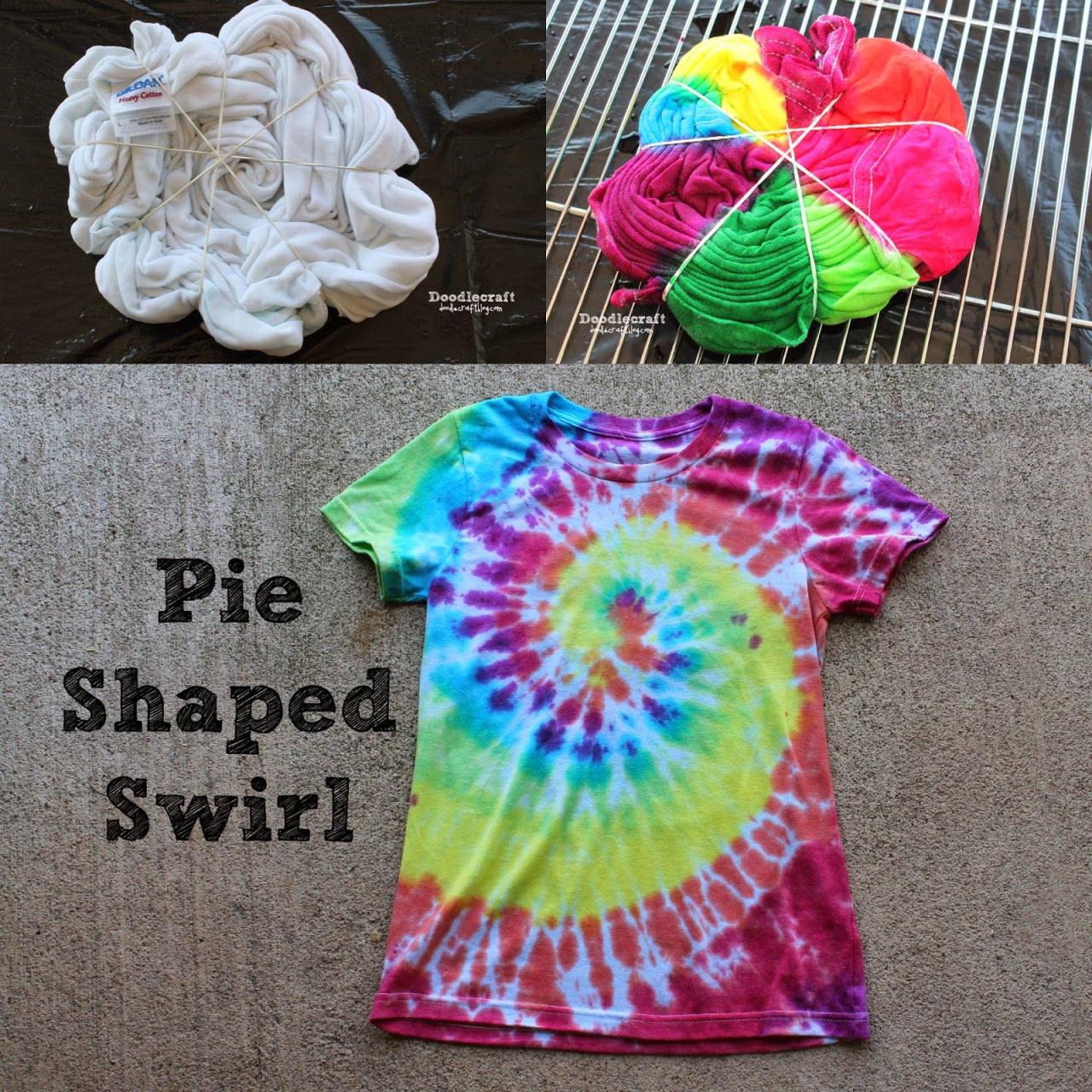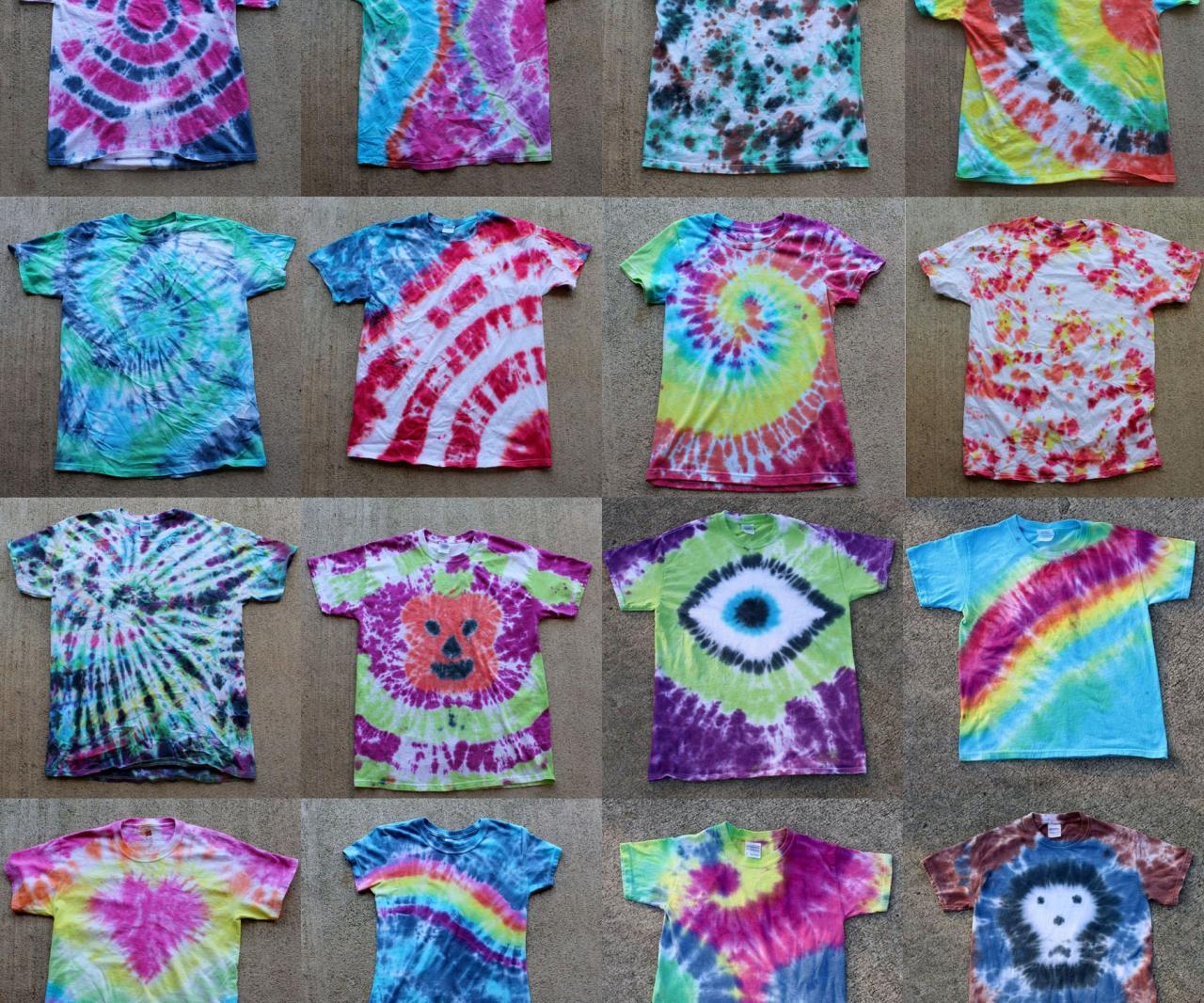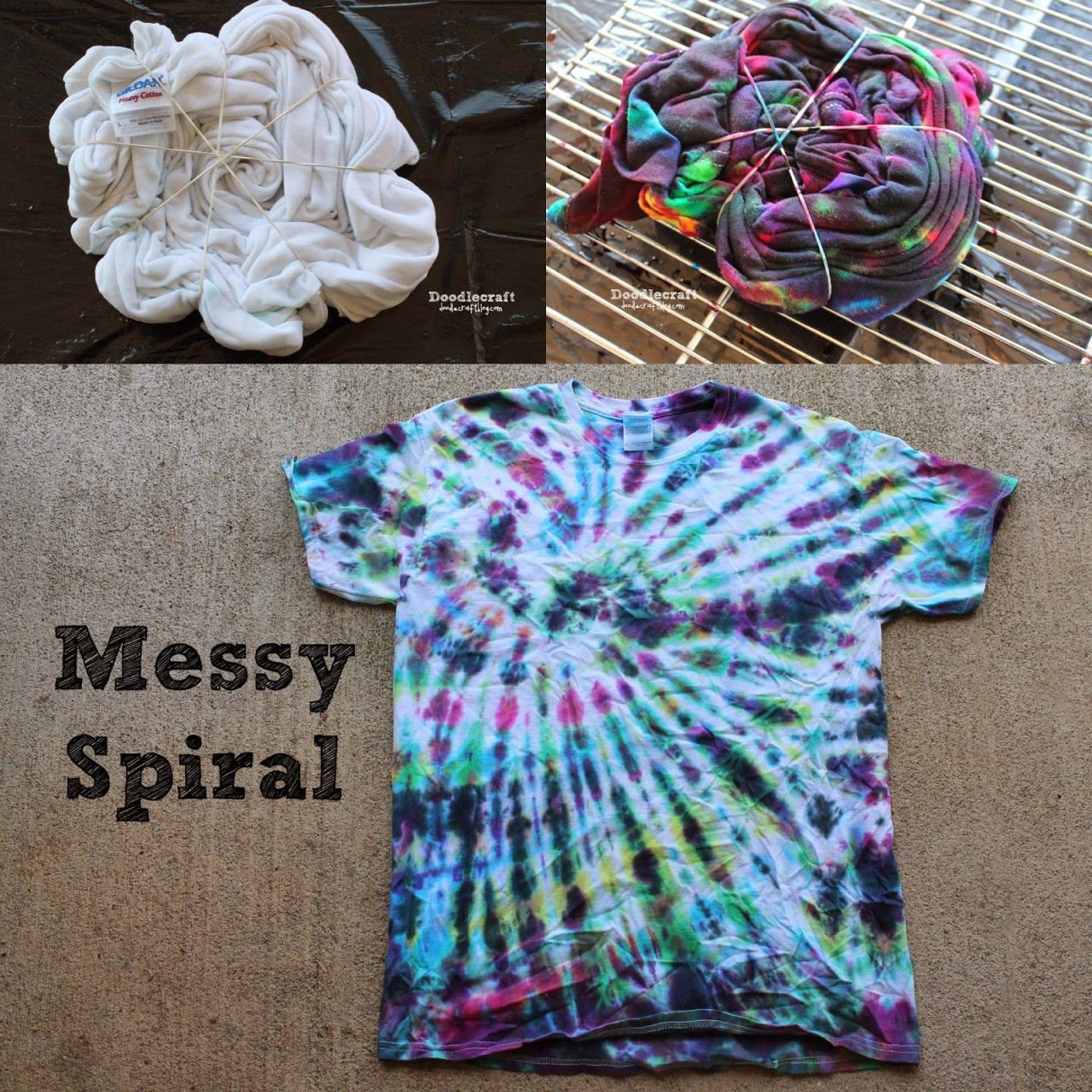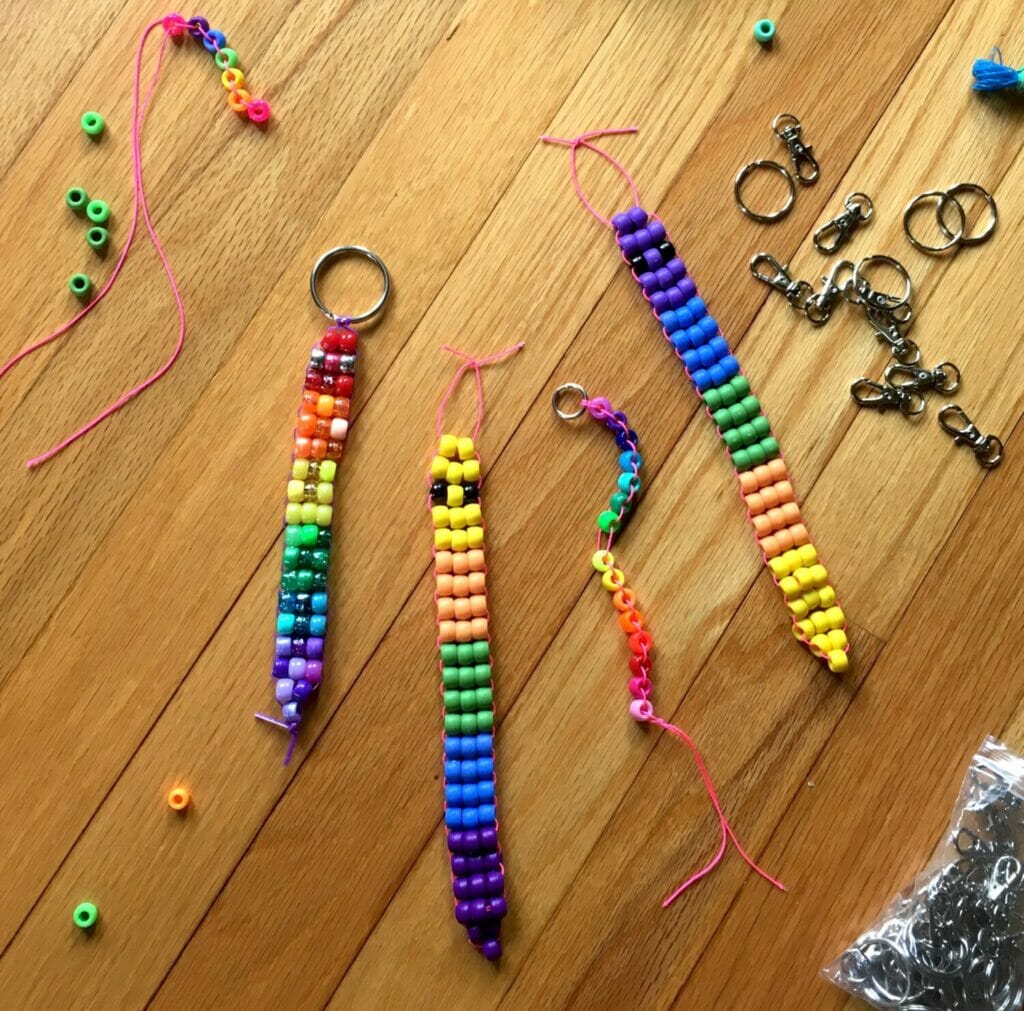DIY tie dye is a fun and creative way to transform plain fabrics into vibrant works of art. It’s a simple process that can be enjoyed by people of all ages and skill levels, allowing you to unleash your inner artist and create personalized clothing, accessories, and home decor. From basic techniques to more intricate methods, the possibilities are endless with tie dye.
This guide will delve into the history and origins of tie dye, explore various techniques, provide tips for achieving stunning results, and offer inspiration for your own tie dye projects. We’ll also discuss the importance of safety precautions and where to find resources for further learning and inspiration.
Basic Tie Dye Techniques
Tie dye is a fun and creative way to personalize clothing and fabric. It involves using rubber bands or string to create patterns on fabric before applying dye. This technique creates unique designs and adds a touch of individuality to your wardrobe.
Tying and Securing Fabric
Before applying dye, you need to prepare the fabric by tying and securing it to create the desired patterns. Here are some basic techniques:
- Crinkle Tie Dye: This technique creates a random, marbled effect. Simply crumple the fabric tightly and secure it with rubber bands. The tighter you crumple, the more intense the marbling effect will be.
- Spiral Tie Dye: To achieve a spiral design, start by folding the fabric into a cone shape. Then, tie the fabric tightly with rubber bands at regular intervals along the cone. The number of rubber bands you use will determine the number of spiral sections in your design.
- Bullseye Tie Dye: This technique creates concentric circles of color. Fold the fabric into a square and then fold it in half again to create a triangle. Place a rubber band around the center of the triangle to create the bullseye effect. You can then add more rubber bands to create smaller circles within the larger one.
Dye Application and Color Blending
Once you have tied the fabric, it’s time to apply the dye. Here are some tips for achieving even dye distribution and color blending:
- Soak the fabric: Before applying dye, it’s important to soak the fabric in water to ensure that the dye penetrates evenly.
- Use a dye bottle: Dye bottles allow you to apply dye precisely and control the amount of dye used.
- Work in a well-ventilated area: Tie dye dyes can stain, so it’s important to work in a well-ventilated area to prevent inhaling the dye fumes.
- Let the dye sit: Once you have applied the dye, allow it to sit for the recommended amount of time (usually 6-8 hours). This will allow the dye to penetrate the fabric and create vibrant colors.
Dyeing Different Fabrics: Diy Tie Dye

Tie dye is a versatile craft that can be applied to various fabrics. Choosing the right fabric for your project is essential for achieving vibrant colors and long-lasting results. This section explores the best fabrics for tie dye, their properties, and how to prepare them for dyeing.
Best Fabrics for Tie Dye
The best fabrics for tie dye are those that are primarily made of natural fibers, such as cotton, silk, and wool. These fibers are absorbent and readily accept dye, producing vibrant and long-lasting results.
Cotton
Cotton is a popular choice for tie dye due to its affordability, availability, and excellent dye absorption. It is also relatively easy to work with, making it suitable for beginners. Cotton’s natural fibers readily accept dye, resulting in vibrant colors that remain vibrant even after washing.
Silk
Silk is another excellent choice for tie dye, known for its luxurious feel and vibrant colors. It is a delicate fabric that requires gentle handling, but the results are stunning. Silk absorbs dye beautifully, producing vibrant and rich colors.
Wool
Wool is a durable and warm fabric that can be tie-dyed, although it requires a different approach than cotton or silk. Wool fibers are more tightly packed, making it less absorbent than cotton or silk. However, wool can be tie-dyed with acid dyes, which are specifically designed for protein fibers like wool.
Preparing Fabrics for Tie Dye
Before dyeing any fabric, it’s essential to prepare it properly to ensure even dye absorption and vibrant colors.
Pre-washing
Always pre-wash your fabric before dyeing to remove any sizing or finishes that may interfere with dye absorption. Washing also helps to soften the fabric, making it easier to tie and dye.
Setting the Fabric
After pre-washing, set the fabric by washing it in a solution of vinegar and water. This helps to set the dye and prevent it from fading.
Dyeing Different Materials
Dyeing Cotton
Cotton is a versatile fabric that can be tie-dyed using a variety of techniques. The most common method is using fiber reactive dyes, which create permanent and vibrant colors.
Dyeing Silk
Silk is a delicate fabric that requires gentle handling. Acid dyes are ideal for silk, as they are gentle and produce vibrant colors.
Dyeing Wool
Wool is a durable fabric that can be tie-dyed using acid dyes. These dyes are specifically designed for protein fibers like wool and produce vibrant and long-lasting colors.
Tie Dye Project Ideas

Tie dye is a fun and creative way to personalize your clothing, accessories, and home decor. The possibilities are endless, and you can create unique and eye-catching designs with just a few simple supplies.
Inspiring Tie Dye Project Examples
Here are some inspiring examples of tie dye projects that you can try:
- T-shirts: Tie dye t-shirts are a classic and popular choice. You can create simple spiral designs, tie dye a whole t-shirt in one color, or create a more complex pattern with multiple colors.
- Socks: Tie dye socks are a fun and quirky way to add some personality to your wardrobe. You can tie dye a pair of socks in matching colors or create a unique design for each sock.
- Bandanas: Tie dye bandanas are a great way to add a pop of color to your outfit. You can tie dye a bandana in a solid color or create a fun and funky pattern.
- Pillowcases: Tie dye pillowcases are a fun and easy way to add a touch of color to your bedroom. You can tie dye a pillowcase in a solid color or create a unique pattern that complements your bedding.
- Reusable Grocery Bags: Tie dye reusable grocery bags are a practical and stylish way to reduce your environmental impact. You can tie dye a bag in a solid color or create a design that reflects your personality.
Designing Tie Dye Projects
To design a tie dye project, consider the following factors:
- Fabric Type: Different fabrics will absorb dye differently. For example, cotton is a popular choice for tie dye because it absorbs dye well and produces vibrant colors.
- Dye Colors: Choose colors that complement each other and create the desired effect. Consider using a color wheel to help you choose colors that will create a harmonious look.
- Tie Dye Techniques: There are many different tie dye techniques that you can use. Experiment with different techniques to find ones that you enjoy and that produce the desired results.
- Design: Consider the design you want to create. Do you want a simple spiral design, a complex pattern, or something in between? Sketch out your design on paper before you start dyeing.
Creating a Tie Dye T-shirt
Here are step-by-step instructions for creating a tie dye t-shirt:
- Gather Your Supplies: You will need a white cotton t-shirt, rubber bands, gloves, a plastic drop cloth, dye, soda ash, and a spray bottle.
- Prepare the Fabric: Wet the t-shirt with water and then soak it in a solution of soda ash and water for 30 minutes. Soda ash helps the dye to penetrate the fabric.
- Tie the Fabric: Use rubber bands to create the desired design. You can tie the fabric in a spiral, crinkle it up, or use other techniques to create different patterns.
- Apply the Dye: Apply the dye to the fabric, making sure to cover all areas of the design. You can use a sponge, brush, or spray bottle to apply the dye.
- Let the Dye Sit: Allow the dye to sit for at least 6 hours or overnight. The longer you let the dye sit, the more vibrant the colors will be.
- Rinse and Wash: Rinse the t-shirt thoroughly with cold water until the water runs clear. Then wash the t-shirt in cold water with a mild detergent.
- Dry: Dry the t-shirt in a dryer or hang it to dry.
Safety Precautions and Tips
Tie-dyeing is a fun and creative activity, but it’s essential to prioritize safety while working with dyes and chemicals. Following proper safety precautions will ensure a pleasant and enjoyable experience.
Protective Gear
Wearing appropriate protective gear is crucial when handling dyes and chemicals. It helps prevent skin and eye irritation, as well as accidental staining of clothing.
- Gloves: Always wear rubber or nitrile gloves to protect your hands from direct contact with dyes and chemicals. Disposable gloves are readily available and are a good choice for tie-dyeing.
- Eye Protection: Safety goggles or glasses are essential to shield your eyes from dye splashes or fumes.
- Protective Clothing: Wear old clothes that you don’t mind getting stained. An apron or a smock can also provide additional protection for your clothes.
Safe Handling of Dyes and Chemicals
- Read the Label: Before using any dye or chemical, carefully read the manufacturer’s instructions and safety precautions on the label.
- Ventilation: Work in a well-ventilated area to avoid inhaling dye fumes. Open windows or use a fan to ensure proper airflow.
- Storage: Store dyes and chemicals in their original containers, tightly sealed, and out of reach of children and pets.
- Water Safety: Avoid direct contact of dyes and chemicals with water sources like sinks or drains. Rinse tools and equipment thoroughly before disposing of wastewater.
Cleaning Up Spills
- Immediate Action: If you spill dye or chemicals, immediately clean it up to prevent staining and potential hazards.
- Absorbent Materials: Use absorbent materials like paper towels, old rags, or kitty litter to soak up spills.
- Cleaning Solutions: Use a mild detergent and water to clean up spills on surfaces. Avoid using harsh chemicals that might react with the dye.
Disposing of Dye Materials
- Local Regulations: Check your local regulations for proper disposal of dye materials and wastewater.
- Dye Packaging: Follow the instructions on the dye packaging for disposal.
- Wastewater: Rinse dye-stained fabrics thoroughly before washing them to minimize dye runoff in wastewater.
Tie Dye Resources and Inspiration

Finding the right resources and inspiration can be a key part of a successful tie-dye project. From finding the best supplies to discovering new techniques, there are many resources available to help you take your tie-dye journey to the next level.
Online Resources
The internet offers a wealth of information and inspiration for tie-dye enthusiasts. Many websites offer a wide range of tie-dye supplies, tutorials, and inspiration.
- Online Retailers: Sites like Amazon, Etsy, and Dharma Trading Company offer a wide variety of tie-dye kits, dyes, and tools. These platforms often provide user reviews and comparisons, making it easier to choose the best products for your needs.
- Tie-Dye Blogs and Websites: Many blogs and websites are dedicated to tie-dye, providing tutorials, tips, and inspiration. Some popular examples include Tie Dye Guru, The Tie Dye Guy, and The Spruce Crafts.
- YouTube Channels: YouTube is a great resource for tie-dye tutorials and inspiration. Many channels offer step-by-step instructions, tips, and tricks, allowing you to learn from experienced tie-dyers.
Books and Magazines
For those who prefer a more tangible resource, books and magazines dedicated to tie-dye offer a wealth of information and inspiration.
- Tie Dye: The Complete Guide to Shibori, Ikat, and More: This book by Susan L. Jones provides a comprehensive guide to tie-dye, covering various techniques, materials, and projects. It features detailed instructions, color theory, and historical context, making it a valuable resource for beginners and experienced dyers alike.
- The Tie Dye Book: This book by Lisa Congdon offers a fun and approachable guide to tie-dye, featuring vibrant illustrations and easy-to-follow instructions. It covers a wide range of techniques, from classic spiral and bullseye patterns to more complex designs.
- Fiberarts Magazine: This magazine features articles on various fiber arts, including tie-dye. It offers insights into new techniques, trends, and inspiration from established and emerging artists.
Social Media
Social media platforms like Instagram, Pinterest, and TikTok have become a hub for tie-dye enthusiasts to share their projects, techniques, and inspiration.
- Inspiration and Ideas: Social media platforms offer a vast library of tie-dye projects, from clothing and accessories to home decor and artwork. This visual inspiration can spark creativity and help you find new ideas for your own projects.
- Community and Connection: Social media platforms provide a space for tie-dye enthusiasts to connect with each other, share their work, and ask questions. This online community can offer support, encouragement, and feedback.
- Tutorials and Techniques: Many tie-dye artists share their techniques and tutorials on social media, offering step-by-step instructions and visual demonstrations. This accessibility allows you to learn from experienced dyers and experiment with different approaches.
Tie Dye Community and Culture
The tie dye community is a vibrant and diverse group of individuals who share a passion for this unique and creative art form. Tie dye has a rich history, evolving from ancient textile dyeing techniques to a modern expression of individuality and artistic freedom.
History of Tie Dye
Tie dye’s origins can be traced back to ancient civilizations across the globe. In India, the art of tie-dyeing, known as “bandhani,” has been practiced for centuries. Similarly, in Japan, “shibori” techniques have been used for centuries to create intricate patterns on fabrics. These ancient traditions laid the foundation for modern tie dye practices.
Tie Dye in Contemporary Art and Fashion
Tie dye has experienced a resurgence in popularity in recent years, becoming a prominent force in contemporary art and fashion. It has transitioned from a counterculture symbol to a mainstream aesthetic, embraced by designers, artists, and fashion enthusiasts alike.
Tie Dye Artists and Their Work
The tie dye community boasts a diverse range of artists who push the boundaries of this art form. Here are some notable examples:
- Spencer Tunick, a renowned photographer, incorporates tie dye into his large-scale, body-art installations, exploring themes of the human form and social commentary.
- Michelle Lesniak, a contemporary artist, uses tie dye as a medium to create intricate and abstract paintings that explore themes of color, texture, and pattern.
- The Tie Dye Guy, a popular Instagram influencer, shares his passion for tie dye through tutorials, vibrant designs, and a strong online community.
Tie Dye Trends and Innovations
Tie dye has undergone a significant revival in recent years, with new techniques, materials, and designs emerging. This resurgence has been fueled by a growing interest in DIY crafts, sustainable fashion, and unique self-expression.
Current Trends in Tie Dye Techniques and Designs
The tie dye scene is constantly evolving, with new techniques and designs emerging regularly. Here are some current trends:
- Spiral Tie Dye: This classic technique involves twisting the fabric into a spiral shape before applying dye, creating a mesmerizing swirl pattern. Variations include using multiple colors or adding shibori elements to create more intricate designs.
- Ombre Tie Dye: This technique creates a gradual transition between two or more colors. It can be achieved by using a sponge or brush to blend the dye or by folding the fabric and applying dye to the edges. Ombre tie dye is often used to create a subtle, elegant effect.
- Reverse Tie Dye: This technique involves using bleach to create a light pattern on a dark fabric. This technique can be used to create intricate designs or to achieve a vintage look.
- Tie Dye with Natural Dyes: There is a growing trend towards using natural dyes, such as turmeric, indigo, and beetroot, to create tie dye designs. Natural dyes are often more environmentally friendly and can create unique and vibrant colors.
- Tie Dye on Different Fabrics: Tie dye is no longer limited to cotton. Experimenting with different fabrics, such as silk, linen, and even leather, opens up new possibilities for design and texture.
New Dyes and Materials in Tie Dyeing, Diy tie dye
The world of tie dye has also seen the introduction of new dyes and materials that enhance the creative possibilities:
- Reactive Dyes: These dyes are highly concentrated and vibrant, offering a wide range of colors. They are also known for their permanence and ability to bond with natural fibers like cotton.
- Acid Dyes: Acid dyes are used to dye silk, wool, and nylon. They are available in a wide range of colors and can be used to create vibrant and intricate designs.
- Dye Sublimation: This technique involves using a special heat-transfer dye that is applied to a fabric with a heat press. Dye sublimation can create intricate designs with sharp lines and vibrant colors.
- Tie Dye Kits: Many companies now offer tie dye kits that include everything you need to get started, from dyes and rubber bands to instructions and inspiration. These kits are a great way to try tie dye without having to invest in individual supplies.
Potential for Future Innovations in Tie Dye
The future of tie dye is bright, with potential for continued innovation:
- Digital Tie Dye: This technology allows for the creation of intricate and unique tie dye designs using digital printing techniques. Digital tie dye can be used to create custom designs or to replicate existing patterns with precision.
- 3D Tie Dye: This emerging technique involves applying dye to three-dimensional objects, such as clothing, shoes, and accessories. This allows for unique and creative designs that go beyond the traditional flat surface.
- Biodegradable Dyes: As sustainability becomes increasingly important, the development of biodegradable dyes for tie dye would be a significant advancement. These dyes would reduce the environmental impact of the craft while still allowing for vibrant and long-lasting designs.
Ultimate Conclusion
Whether you’re a seasoned tie dye enthusiast or a curious beginner, we hope this guide has sparked your creativity and provided the tools you need to embark on your own tie dye journey. So gather your supplies, unleash your imagination, and let the colors flow! With a little practice and experimentation, you’ll be creating dazzling tie dye masterpieces in no time.
DIY tie dye is a fun and creative way to personalize clothing and accessories. If you’re looking for a unique and thoughtful Mother’s Day gift, consider creating a tie-dye masterpiece for Mom. You can find inspiration for easy Mother’s Day crafts, including tie-dye projects, here.
With a little creativity and some colorful dye, you can create a truly one-of-a-kind gift that Mom will cherish.

